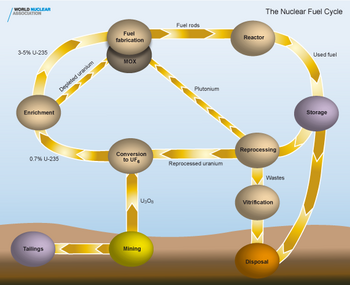Uranium fuel cycle
Jump to navigation
Jump to search

- See also: Nuclear_power_reconsidered

© Image: World Nuclear Association
The complete uranium fuel cycle, showing primary and recycled materials flow.[1]
The complete uranium fuel cycle, showing primary and recycled materials flow.[1]
This article should address the issues raised by opponents of nuclear power, including hazards and environmental impacts at every step from mining to final disposal of radioactive waste.
There is only one fissile nuclide occurring in nature - uranium 235, which is a small fraction of naturally occurring uranium. Other fissile nuclides may be produced by neutron irradiation of much more abundant "fertile" nuclides.
Nuclear transmutations
Fissile U-235, 0.7% of natural uranium, crustal abundance 19.44 ppb, 4.83 MJ/liter.
- → Fission Products + 211.3 MeV → 86.75 TJ/kg
Fertile U-238, 99.3% of natural uranium, crustal abundance 2.7 ppm, 652 MJ/liter.
- → → Fission Products + 211.5 MeV → 85.38 TJ/kg
Fertile Th-232, crustal abundance 12ppm, 2,813 MJ/liter.
- → → Fission Products + 200.1 MeV → 82.86 TJ/kg




